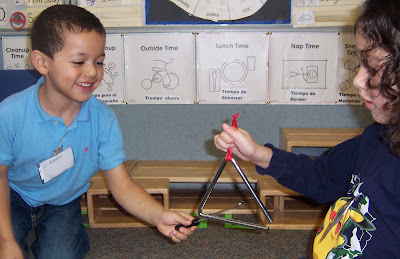Exploring sound and music as part of science learning
By Peggy Ashbrook
Posted on 2010-12-15
 Exploring how sound is made is one way music is used in early childhood classrooms. I like to use a triangle to focus children’s attention on the tiny movement that generates the sound. They touch the still triangle and then remove their hand. I strike the triangle to make the sound and they touch it again (and shiver or giggle as the vibration tickles their fingers).
Exploring how sound is made is one way music is used in early childhood classrooms. I like to use a triangle to focus children’s attention on the tiny movement that generates the sound. They touch the still triangle and then remove their hand. I strike the triangle to make the sound and they touch it again (and shiver or giggle as the vibration tickles their fingers).
Next we pass the triangle and striker around the circle and one child holds the triangle while the other uses the striker. This way no one person can monopolize the equipment and we all get to feel the vibrations again. Sometimes in passing the triangle a child will hold the side of the instrument rather than the string and the resulting “thunk” (rather than a musical note) opens a discussion of how to change sounds.
Early childhood advocate and musician Miss Jackie lists many other reasons for using music in her November 11, 2010, blog posting, Music belongs in early childhood classrooms:
- Encourages taking turns. Partner songs and playing instruments teach sharing and respect for others.
- Builds self confidence. Singing songs and doing actions give children a feeling of power and control. These feelings of self esteem transfer to other aspects of life.
- Builds friendships. Group interaction is a positive way to develop relationships.
- Develops coordination. Actions with songs and movement are important for large and small muscle growth.
- Develops rhythm. Rhythm is necessary for understanding ourselves and the world.
- Inspires imagination. Music encourages children to use their imagination.
- Develops concentration and ability to focus. Memorizing words, listening for certain sounds are all part of this experience.
The skills of taking turns, building friendships, and ability to focus all contribute to learning science concepts. I use songs passed on to me by other teachers for transitions—to clean up or to gather the children in a circle for group time. “Take a seat on the floor, take a seat on the floor, all my friends come and take a seat on the floor. Not on the ceiling, not on the door, all my friends come and take a seat on the floor.” After a few weeks I do not sing the words “ceiling” and “door” but just point to them while the children sing. This transition song is effective because the humor and small act of participating helps them disengage from their previous activities. (In the best tradition of folk music, the tune I learned is not “Shortening Bread” as most online sites report, but has changed a bit.) See online versions of this song at: www.songsforteaching.com/b/everybodyhaveaseat.htm and
http://www.preschooleducation.com/stransition.shtml
Where does music fit into your science teaching?
Peggy
Disclaimer: The views expressed in this blog post are those of the author(s) and do not necessarily reflect the official position of the National Science Teaching Association (NSTA).


